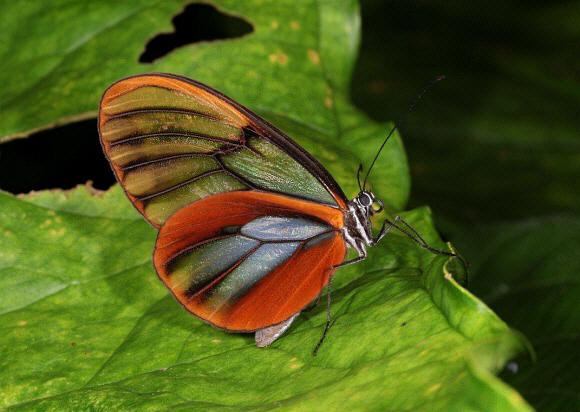
Introduction
The Ithomiini comprises of 376 known species, although it is likely that at least another 30 will be discovered in the near future. All are confined to the neotropical region. Ithomiines are unpalatable to birds, and are consequently mimicked in appearance by many other species. These include other unpalatable species ( Müllerian mimics ), not only from the Ithomiinae but also from several other butterfly families. There are also a large number of edible species ( Batesian mimics ) which have evolved similar patterns. Birds have the ability to memorise butterfly patterns and so learn to avoid eating noxious species, but are also fooled into ignoring similarly marked edible species.
Ithomiines are characterised by having small eyes, slender abdomens and long drooping antennae that lack distinct clubs. Males have a plume of long androconial scales or “hair pencils” on the costa of their hindwings. These are hidden from view when the butterflies are at rest, but are displayed when the wings are held open during courtship. Other Ithomiine characteristics include a very slow and deep wing beat, and a preference for inhabiting the darkest recesses of the forest understorey.
There are basically 2 types of Ithomiine. The first type are the black and orange-banded “tigers”, many of which are mimicked by other species due to their unpalatability to birds. The second type are the “glasswings”, recognised by their transparent or translucent wings, prominent veins, and orange wing margins. Many genera contain examples of both of these types, and in some cases an individual species may produce adults of both forms according to location.
The genus Godyris comprises 14 very attractive species, characterised by their distinctive venation.
Godyris duillia is found in Colombia, Venezuela and Ecuador.
Habitats
This species inhabits rainforest habitats at altitudes between about 200-1000m.
Lifecycle
I have no information specific to duillia but the lifecycle is likely to be similar to that of zavaleta as follows: The egg is white and laid singly on the foliage of Solanaceae. The larva is naked and pale translucent green in colour, with a shiny yellow head. It feeds diurnally on Solanum. The chrysalis is also pale translucent green, dotted with black on the wing cases. It is squat in shape with a strongly humped back, and suspended from the underside of leaves.
Adult behaviour
The butterflies are normally encountered singly. They are rather inactive, and fly slowly with deep wing-beats, but can put on a quick turn of speed if disturbed.
Males feed at the stems of Eupatorium and Heliotropium, from which they sequester pyrrolizidine alkaloids. These are processed within their bodies to produce pheromones which are disseminated from androconial scales in the form of “hair pencils” on the leading edge of the hindwings. They can sometimes be seen slowly fanning their wings to disperse the pheromones.
